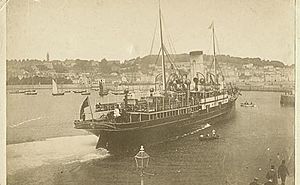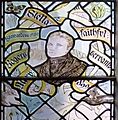SS Stella (1890) facts for kids

SS Stella
|
|
Quick facts for kids History |
|
|---|---|
| Name | Stella |
| Owner | London and South Western Railway |
| Port of registry | Southampton |
| Route | Southampton - Channel Islands |
| Builder | J & G Thompson, Clydebank |
| Cost | £62,000 |
| Yard number | 252 |
| Launched | 16 September 1890 |
| Completed | October 1890 |
| Out of service | 30 March 1899 |
| Identification | United Kingdom Official Number 97219 |
| Fate | Wrecked on The Casquets, Channel Islands |
| General characteristics | |
| Tonnage | 1,059 GRT |
| Length | 253 ft (77.11 m) |
| Beam | 35 ft (10.67 m) |
| Propulsion | 2 x triple expansion steam engines |
| Speed | 19½ knots (36 km/h) |
| Capacity | 712 passengers |
| Crew | 43 |
The SS Stella was a passenger ferry that worked for the London and South Western Railway (LSWR). Sadly, on March 30, 1899, it sank near the Casquets rocks while traveling from Southampton to Guernsey.
Contents
Building the Stella
The Stella was built by a company called J & G Thompson Ltd in Clydebank, Scotland. It was launched on September 15, 1890, and finished later that year. The ship weighed 1,059 tons.
It had two powerful steam engines that allowed it to travel at 19.5 knots (about 36 kilometers per hour). The Stella was 253 feet (77 meters) long and 35 feet (11 meters) wide. It could carry 712 passengers. For safety, it had 754 lifejackets, 12 lifebuoys, and lifeboats for 148 people. The Stella had two sister ships, the Frederica and the Lydia.
The Shipwreck of the Stella
The Stella was mainly used for trips between Southampton and the Channel Islands. On March 30, 1899, which was Maundy Thursday, the ship left Southampton heading for St Peter Port, Guernsey. There were 147 passengers and 43 crew members on board. Many people were traveling for the Easter holiday or returning home.
The Stella left Southampton at 11:25 AM. After passing The Needles, it sailed at full speed across the English Channel. The ship went through some fog banks, and its speed was slowed down twice. As it got closer to the Channel Islands, it entered another fog bank, but this time, the speed was not reduced.
The Collision
Just before 4:00 PM, the fog signal from the Casquets Lighthouse was heard. Suddenly, the Casquets rocks appeared right in front of the ship. Captain Reeks quickly ordered the engines to go backward and tried to turn the ship away from the rocks.
The Stella scraped against two rocks. Then, its bottom was torn open by a hidden granite reef underwater. The ship sank very quickly, in just eight minutes.
Rescuing Survivors
Four lifeboats were successfully launched. A fifth lifeboat flipped over. The rule of "women and children first" was followed. One brave stewardess, Mary Ann Rogers, gave her lifejacket to someone else and refused a spot in a lifeboat.
The capsized lifeboat was later flipped upright by a huge wave. Twelve people managed to climb into it. Sadly, four of them died from the cold during the night. The remaining eight survivors were rescued by a French Naval tugboat named Marsouin.
One lifeboat, carrying 38 survivors, was towing a smaller boat with 29 survivors. These two boats were spotted at 7:00 AM on March 31 by another LSWR ship, the Vera. They were picked up and taken to St Helier, Jersey.
Another small boat, with 24 survivors, was towing a dinghy with 13 survivors. They were rescued by the Great Western Railway (GWR) ship Lynx, which was sailing from Weymouth to St Peter Port. The LSWR ship Honfleur also helped search for survivors.
In total, 86 passengers and 19 crew members died in the sinking.
A Heroine's Song
Famous English opera singer Greta Williams was a passenger on the Stella. She was praised for comforting the frightened survivors while they waited to be rescued. A poem by William McGonagall about the shipwreck included these lines:
But the sufferings of the survivors are pitiful to hear, And I think all Christian people for them will drop a tear, Because the rowers of the boats were exhausted with damp and cold; And the heroine of the wreck was Miss Greta Williams, be it told.
She remained in as open boat with her fellow-passengers and crew, And sang "O rest in the Lord, and He will come to our rescue"; And for fourteen hours they were rowing on the mighty deep, And when each man was done with his turn he fell asleep.
The remains of the Stella were found in June 1973 by two divers from the Channel Islands. The wreck lies 49 meters (161 feet) deep, south of the Casquets.
The Official Investigation
The Board of Trade held an investigation into the shipwreck. It started on April 27, 1900, and lasted six days. Some people claimed that the Stella had been racing against another ship from the GWR. The LSWR denied this.
The investigation could not say for sure if there had been a race. However, they decided that Captain William Reeks was entirely responsible for continuing at full speed in the fog. This finding allowed many families who had lost loved ones to seek payments from the LSWR. After a long legal process, the company had to pay money to many of the affected families.
Remembering the Stella
Memorials in the Channel Islands
There is a metal plaque at St Peter Port Harbour that remembers the Stella shipwreck. Alderney, one of the Channel Islands, issued special postage stamps in 1999 and again in 2019 to mark the anniversary of the sinking.
Memorials in England
- Liverpool: In Liverpool Cathedral, Mary Ann Rogers is honored in a stained glass window. She is one of eight women remembered there for their brave actions.
- London: Mary Ann Rogers is also remembered on the "Memorial to Heroic Self-Sacrifice" in Postman's Park, London.
- Southampton: The Stella Memorial in Southampton remembers the shipwreck, especially the brave actions of Mary Ann Rogers. People donated money to build this memorial. Part of the money raised also went to Mary Ann Rogers' family.
Images for kids




